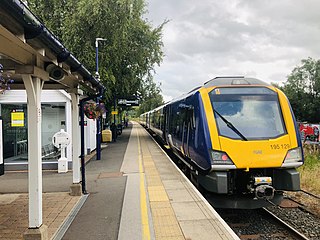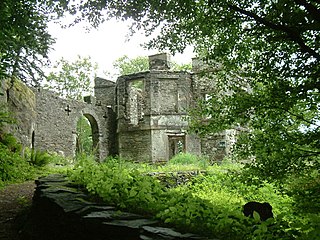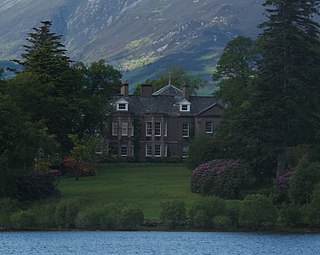Related Research Articles

Transhumance is a type of pastoralism or nomadism, a seasonal movement of livestock between fixed summer and winter pastures. In montane regions, it implies movement between higher pastures in summer and lower valleys in winter. Herders have a permanent home, typically in valleys. Generally only the herds travel, with a certain number of people necessary to tend them, while the main population stays at the base. In contrast, movement in plains or plateaus (horizontal transhumance) is more susceptible to disruption by climatic, economic, or political change.

Furness is a peninsula and region of Cumbria, England. Together with the Cartmel Peninsula it forms North Lonsdale, historically an exclave of Lancashire. On 1 April 2023 it became part of the new unitary authority of Westmorland and Furness.
Wasdale is a valley and civil parish in the western part of the Lake District National Park in Cumbria, England. The River Irt flows through the valley to its estuary at Ravenglass. A large part of the main valley floor is occupied by Wastwater, the deepest lake in England.

Windermere railway station serves Windermere in Cumbria, England. It is the terminus of the Windermere Branch Line, which runs from Oxenholme. It is owned by Network Rail and is operated by Northern Trains who provide all passenger train services.

Kendal railway station serves the market town of Kendal in Cumbria, England. It is a stop on the Windermere branch line, which runs between Oxenholme to Windermere. The station is owned by Network Rail and is operated by Northern Trains, who provide all passenger services.

Burneside railway station is in Burneside, Cumbria, England. The station is situated on the Windermere Branch Line from Oxenholme to Windermere. To the east of the station can be found the only two semaphore signals on the line guarding the manually operated road crossing. The station is owned by Network Rail and is operated by Northern who provide all passenger train services.

Staveley railway station is a railway station in Staveley in Cumbria, England. The station is on the Windermere Branch Line connecting Oxenholme and Windermere. The station is owned by Network Rail and is operated by Northern Trains who provide all passenger train services, Staveley was a request stop until December 2012.

Hawkshead and Claife is a National Trust property made up of much of the town of Hawkshead and surrounding Claife Woodlands in Cumbria, England. Overlooking Windermere itself is Claife Station, the ruins of a residence notable for the fact that each room was glazed in differing coloured glass to give the effect of viewing the landscape in the changing seasons.
Acorn Bank Garden & Watermill is a National Trust property situated just north of Temple Sowerby, near Penrith, Cumbria, England.

Derwent Island House is a Grade II listed 18th-century Italianate house situated on the seven-acre (three-hectare) Derwent Island, Derwent Water, Keswick, Cumbria, and in the ownership of the National Trust. It is leased as a private home, but is open to the public five days a year. The interior is neoclassical in style.
Windermere and Troutbeck (including Bridge House) is a National Trust property consisting of land around Windermere, a lake in Cumbria, England.

Lambrigg Fell is a hill, the highest point of the area of high ground between Kendal and the M6, in south-eastern Cumbria, England.
Troutbeck Park is a farm to the north of Troutbeck village in South Lakeland, Cumbria. In 1923, there was a risk of it being sold for development, so Beatrix Potter bought it and kept it as a working farm. She bred Herdwick sheep there with the help of shepherd Tom Storey. When she died in 1943 she was president-elect of the Herdwick Sheep Breeders' Association, though she died before she could take up office.

Blackwell is a large house in the English Lake District, designed in the Arts and Crafts style by Baillie Scott. It was built in 1898–1900, as a holiday home for Sir Edward Holt, a wealthy Manchester brewer. It is near the town of Bowness-on-Windermere with views looking over Windermere and across to the Coniston Fells.

Purple moor grass and rush pastures is a type of Biodiversity Action Plan habitat in the UK. It occurs on poorly drained neutral and acidic soils of the lowlands and upland fringe. It is found in the southwest of England, especially in Devon.
The Battle of Annan Moor took place during the Scottish civil war, part of the intertwined Wars of the Three Kingdoms that took place in England, Ireland, and Scotland between 1639 and 1651.

Storrs Hall is a hotel on the banks of Windermere in Storrs in the Lake District, Cumbria, England. The hotel, a Grade II* listed Georgian mansion, is also home to the National Trust-owned folly the "Temple" on the end of a stone jetty on Windermere.

School Knott is a hill in the Lake District, England, to the east of Windermere town, Cumbria. It is the subject of a chapter of Wainwright's book The Outlying Fells of Lakeland. His recommended route starts at Windermere railway station and includes Grandsire at 818 feet (249 m) and a nameless summit at 806 feet (246 m). The summit is at 760 feet (230 m) and offers a view of four sections of Windermere, the lake. It has a rocky outcrop but no trig point and, as reported by Wainwright, no cairn. Schoolknott Tarn is to the south-east of the summit.

Winster is a village in the Westmorland and Furness district of Cumbria, in North West England. Historically within the county of Westmorland, it is situated less than two miles east of Windermere, England's largest natural lake. The village is within the Lake District National Park. The village has a pub, the Brown Horse Inn, an 1850s coaching inn.
References
- ↑ Countryfile, 17 September 2017
- ↑ Experience High Lickbarrow Farm in Windermere, National Trust
- ↑ Teresa Morris (1988), High Lickbarrow Mires and Pastures SSSI, Natural England
54°22′07″N2°53′45″W / 54.3685°N 2.8959°W